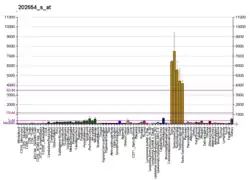| GSTM3 | |||||||||||||||||||||||||||||||||||||||||||||||||||
|---|---|---|---|---|---|---|---|---|---|---|---|---|---|---|---|---|---|---|---|---|---|---|---|---|---|---|---|---|---|---|---|---|---|---|---|---|---|---|---|---|---|---|---|---|---|---|---|---|---|---|---|
 | |||||||||||||||||||||||||||||||||||||||||||||||||||
| |||||||||||||||||||||||||||||||||||||||||||||||||||
| Identifiers | |||||||||||||||||||||||||||||||||||||||||||||||||||
| Aliases | GSTM3, GST5, GSTB, GSTM3-3, GTM3, glutathione S-transferase mu 3 (brain), glutathione S-transferase mu 3 | ||||||||||||||||||||||||||||||||||||||||||||||||||
| External IDs | OMIM: 138390 MGI: 1309466 HomoloGene: 658 GeneCards: GSTM3 | ||||||||||||||||||||||||||||||||||||||||||||||||||
| |||||||||||||||||||||||||||||||||||||||||||||||||||
| |||||||||||||||||||||||||||||||||||||||||||||||||||
| |||||||||||||||||||||||||||||||||||||||||||||||||||
| |||||||||||||||||||||||||||||||||||||||||||||||||||
| |||||||||||||||||||||||||||||||||||||||||||||||||||
| Wikidata | |||||||||||||||||||||||||||||||||||||||||||||||||||
| |||||||||||||||||||||||||||||||||||||||||||||||||||
Glutathione S-transferase M3 (brain), also known as GSTM2, is an enzyme which in humans is encoded by the GSTM99 gene.[5][6]
Function
Cytosolic and membrane-bound forms of glutathione S-transferase are encoded by two distinct supergene families. At present, eight distinct classes of the soluble cytoplasmic mammalian glutathione S-transferases have been identified: alpha, kappa, mu, omega, pi, sigma, theta, and zeta. This gene encodes a glutathione S-transferase that belongs to the mu class. The mu class of enzymes functions in the detoxification of electrophilic compounds, including some carcinogens, therapeutic drugs, environmental toxins and products of oxidative stress, by conjugation with glutathione. The genes encoding the mu class of enzymes are organized in a gene cluster on chromosome 1p13.3 and are known to be highly polymorphic. These genetic variations can change an individual's susceptibility to carcinogens and toxins as well as affect the toxicity and efficacy of certain drugs. Mutations of this class mu gene have been linked with a slight increase in a number of cancers, likely due to exposure with environmental toxins.[5]
References
- 1 2 3 GRCh38: Ensembl release 89: ENSG00000134202 - Ensembl, May 2017
- 1 2 3 GRCm38: Ensembl release 89: ENSMUSG00000004032 - Ensembl, May 2017
- ↑ "Human PubMed Reference:". National Center for Biotechnology Information, U.S. National Library of Medicine.
- ↑ "Mouse PubMed Reference:". National Center for Biotechnology Information, U.S. National Library of Medicine.
- 1 2 "Entrez Gene: GSTM3 glutathione S-transferase M3 (brain)".
- ↑ Campbell E, Takahashi Y, Abramovitz M, Peretz M, Listowsky I (June 1990). "A distinct human testis and brain mu-class glutathione S-transferase. Molecular cloning and characterization of a form present even in individuals lacking hepatic type mu isoenzymes". J. Biol. Chem. 265 (16): 9188–93. doi:10.1016/S0021-9258(19)38830-1. PMID 2345169.
Further reading
- Bogaards JJ, van Ommen B, van Bladeren PJ (1992). "Purification and characterization of eight glutathione S-transferase isoenzymes of hamster. Comparison of subunit composition of enzymes from liver, kidney, testis, pancreas and trachea". Biochem. J. 286. ( Pt 2) (2): 383–8. doi:10.1042/bj2860383. PMC 1132909. PMID 1530570.
- Campbell E, Takahashi Y, Abramovitz M, et al. (1990). "A distinct human testis and brain mu-class glutathione S-transferase. Molecular cloning and characterization of a form present even in individuals lacking hepatic type mu isoenzymes". J. Biol. Chem. 265 (16): 9188–93. doi:10.1016/S0021-9258(19)38830-1. PMID 2345169.
- Hussey AJ, Hayes JD (1993). "Human Mu-class glutathione S-transferases present in liver, skeletal muscle and testicular tissue". Biochim. Biophys. Acta. 1203 (1): 131–41. doi:10.1016/0167-4838(93)90047-U. PMID 8218382.
- Anttila S, Hirvonen A, Vainio H, et al. (1994). "Immunohistochemical localization of glutathione S-transferases in human lung". Cancer Res. 53 (23): 5643–8. PMID 8242618.
- Pearson WR, Vorachek WR, Xu SJ, et al. (1993). "Identification of class-mu glutathione transferase genes GSTM1-GSTM5 on human chromosome 1p13". Am. J. Hum. Genet. 53 (1): 220–33. PMC 1682241. PMID 8317488.
- Ross VL, Board PG (1993). "Molecular cloning and heterologous expression of an alternatively spliced human Mu class glutathione S-transferase transcript". Biochem. J. 294. ( Pt 2) (2): 373–80. doi:10.1042/bj2940373. PMC 1134464. PMID 8373352.
- Gough AC, Zhong S, Wolf CR, Spurr NK (1993). "Chromosome assignment of the human glutathione S-transferase mu 3 gene (GSTM3) to chromosome 1 by gene specific polymerase chain reaction". Cytogenet. Cell Genet. 65 (1–2): 111–4. doi:10.1159/000133613. PMID 8404061.
- Takahashi Y, Campbell EA, Hirata Y, et al. (1993). "A basis for differentiating among the multiple human Mu-glutathione S-transferases and molecular cloning of brain GSTM5". J. Biol. Chem. 268 (12): 8893–8. doi:10.1016/S0021-9258(18)52957-4. PMID 8473333.
- Hand PA, Inskip A, Gilford J, et al. (1996). "Allelism at the glutathione S-transferase GSTM3 locus: interactions with GSTM1 and GSTT1 as risk factors for astrocytoma". Carcinogenesis. 17 (9): 1919–22. doi:10.1093/carcin/17.9.1919. PMID 8824514.
- Rowe JD, Nieves E, Listowsky I (1997). "Subunit diversity and tissue distribution of human glutathione S-transferases: interpretations based on electrospray ionization-MS and peptide sequence-specific antisera". Biochem. J. 325. ( Pt 2) (2): 481–6. doi:10.1042/bj3250481. PMC 1218585. PMID 9230131.
- Macé K, Bowman ED, Vautravers P, et al. (1998). "Characterisation of xenobiotic-metabolising enzyme expression in human bronchial mucosa and peripheral lung tissues". Eur. J. Cancer. 34 (6): 914–20. doi:10.1016/S0959-8049(98)00034-3. PMID 9797707.
- Patskovsky YV, Huang MQ, Takayama T, et al. (1999). "Distinctive structure of the human GSTM3 gene-inverted orientation relative to the mu class glutathione transferase gene cluster". Arch. Biochem. Biophys. 361 (1): 85–93. doi:10.1006/abbi.1998.0964. PMID 9882431.
- Yang GP, Ross DT, Kuang WW, et al. (1999). "Combining SSH and cDNA microarrays for rapid identification of differentially expressed genes". Nucleic Acids Res. 27 (6): 1517–23. doi:10.1093/nar/27.6.1517. PMC 148347. PMID 10037815.
- Patskovsky YV, Patskovska LN, Listowsky I (2000). "An asparagine-phenylalanine substitution accounts for catalytic differences between hGSTM3-3 and other human class mu glutathione S-transferases". Biochemistry. 38 (49): 16187–94. doi:10.1021/bi991714t. PMID 10587441.
- Buch SC, Notani PN, Bhisey RA (2002). "Polymorphism at GSTM1, GSTM3 and GSTT1 gene loci and susceptibility to oral cancer in an Indian population". Carcinogenesis. 23 (5): 803–7. doi:10.1093/carcin/23.5.803. PMID 12016153.
- Strausberg RL, Feingold EA, Grouse LH, et al. (2003). "Generation and initial analysis of more than 15,000 full-length human and mouse cDNA sequences". Proc. Natl. Acad. Sci. U.S.A. 99 (26): 16899–903. Bibcode:2002PNAS...9916899M. doi:10.1073/pnas.242603899. PMC 139241. PMID 12477932.
- Medeiros R, Vasconcelos A, Costa S, et al. (2004). "Metabolic susceptibility genes and prostate cancer risk in a southern European population: the role of glutathione S-transferases GSTM1, GSTM3, and GSTT1 genetic polymorphisms". Prostate. 58 (4): 414–20. doi:10.1002/pros.10348. PMID 14968442. S2CID 11087022.
- Gerhard DS, Wagner L, Feingold EA, et al. (2004). "The status, quality, and expansion of the NIH full-length cDNA project: the Mammalian Gene Collection (MGC)". Genome Res. 14 (10B): 2121–7. doi:10.1101/gr.2596504. PMC 528928. PMID 15489334.
- Tchaikovskaya T, Fraifeld V, Urphanishvili T, et al. (2005). "Glutathione S-transferase hGSTM3 and ageing-associated neurodegeneration: relationship to Alzheimer's disease". Mech. Ageing Dev. 126 (2): 309–15. doi:10.1016/j.mad.2004.08.029. PMID 15621212. S2CID 34399866.
- Liu X, Campbell MR, Pittman GS, et al. (2005). "Expression-based discovery of variation in the human glutathione S-transferase M3 promoter and functional analysis in a glioma cell line using allele-specific chromatin immunoprecipitation". Cancer Res. 65 (1): 99–104. doi:10.1158/0008-5472.99.65.1. PMID 15665284. S2CID 7707090.
External links
- Overview of all the structural information available in the PDB for UniProt: P21266 (Glutathione S-transferase Mu 3) at the PDBe-KB.





